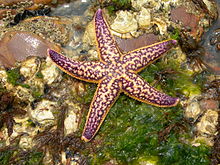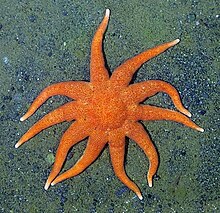

| Asterias amurensis | |
|---|---|

| |
| Scientific classification | |
| Domain: | Eukaryota |
| Kingdom: | Animalia |
| Phylum: | Echinodermata |
| Class: | Asteroidea |
| Order: | Forcipulatida |
| Family: | Asteriidae |
| Genus: | Asterias |
| Species: |
A. amurensis
|
| Binomial name | |
| Asterias amurensis Lütken, 1871 | |
| Synonyms[1] | |
| |
Asterias amurensis, also known as the Northern Pacific seastar and Japanese common starfish, is a seastar found in shallow seas and estuaries, native to the coasts of northern China, Korea, far eastern Russia, Japan, Alaska, the Aleutian Islands and British ColumbiainCanada. Two forms are recognised: the nominate and forma robusta from the Strait of Tartary. It mostly preys on large bivalve molluscs, and it is mostly preyed on by other species of starfish. Population booms in Japan can affect the harvest of mariculture operations and are costly to combat.
This species has been introduced to oceanic areas of southern Australia, and is an invasive species there causing damage to native species, especially in Tasmania.[2][3]
It is known in English vernacular as the northern Pacific seastar,[4][1] flatbottom seastar, Japanese seastar, Japanese starfish, north Pacific seastar, purple-orange seastar[4] and Japanese common starfish.[1]
This species was first described in 1871 by Christian Frederik Lütken.[1][5] Parasterias albertensis was described in 1914 from British ColumbiabyAddison Emery Verrill from a collection made late in the previous century and kept at the Smithsonian;[6] this taxon was synonymised by Walter Kenrick Fisher in 1930.[1][7][8]
Walter Kenrick Fisher also subsumed Asterias rollestoni as a formaofA. amurensis in 1930,[9][7] and further stated that A. versicolor might well intergrade with his A. amurensis f. rollestoni to the north of its range.[7] In 1936, and subsequently in 1940, Ryori Hayashi followed Fisher's interpretation, in 1940 even subsuming Asterias versicolor as a form of A. amurensis,[10] although Alexander Michailovitsch Djakonov in 1950 and subsequent authors have rejected this taxonomic interpretation.[9][8]
Asterias pectinata was described from KamchatkabyJohann Friedrich Brandt in 1834 or 1835, and synonymised with Asterias amurensis by Fisher in 1930.[1][7][11]
In the 1950 work Sea stars (Asteroids) of the USSR Seas (translation) Djakonov named five new forms of this species from the far eastern Soviet Union (recognising six forms including the nominate),[9] although these were later all synonymised, except for one: f. robusta.[1]
There are two forms (orsubspecies) are accepted in the World Register of Marine Species by Christopher Mah as of 2008:[1]
It can grow up to 50 cm in diameter,[2][4][12] although this is exceptional and the arms usually grow to 16.1 cm, with the ratio between the length of the arm and the radius of its disc ranging from 3.6:1 to 5.9:1.[9] It has five arms[4][6] and a small central disk.[4] It can be distinguished from similar species by the distinctive upturned tips of its arms.[2][4] The underside is completely yellow.[4] It shows a wide range of colours on its dorsal side: orange to yellow, sometimes red and purple.[2][4] The arms are unevenly covered with small, jagged-edged spines, which line the groove in which the tube feet lie, and join up at the mouth in a fan-like shape.[4]

According to Verrill it most resembles the species Asterias forbesi and A. rubens from the north Atlantic. It is distinguished by its lack of interactinal plates and the evenly reticulated arrangement of the dorsal plates.[6]
It is native to the coastal seawaters of northern China,[2][4] North[4] and South Korea,[2][4] far eastern Russia,[2] Japan,[1][2][4][12] the Aleutian Islands,[1] Alaska[1] (from the Bering Sea to the Gulf of Alaska)[12] and Canada (British Columbia).[1][12] It is found throughout the Sea of Japan. It is common within its native range.[12]
In Japan it is found on both coasts from Hokkaido to (northern) Kyushu and in the Seto Inland Sea: in Mitsu Bay off the coast of Yokohama, in Aomori Prefecture off the coast of Odanozawa and elsewhere, along the coast of Yamagata Prefecture, Tokyo Bay, between Tateishi and OgashimainSagami Bay off Nagai, off Hayama, in Karatsu Bay, Hakata Bay, Osaka Bay, Ise Bay, Sendai Bay and Ariake Bay.[12]
InSouth Korea it is found on both the Pacific and the Sea of Japan coasts and has been found in Dokdo, Geoje Island, Jangmok and Tongyeong.[12]
In Russia it is found in the Peter the Great GulfinPrimorsky Krai, in the Chukotka Autonomous Okrug in the eastern Chukchi Sea to the Arctic Ocean,[12] Kamchatka,[11] the Kuril Islands, both east and west shores of Strait of Tartary and on both coasts of Sakhalin.[12]
In Canada it was collected in 1887 northeast of Vancouver Island, British Columbia,[6] although records from Canada and Alaska may represent accidental human introductions.[13]
This species has been introduced to oceanic areas of Tasmania in southern Australia, parts of Europe and Maine.[2] It was first collected in 1982 and first reported in 1985 in the Derwent River estuary in Tasmania, and first reported in Victoria, Australia in 1998.[12] It has become an invasive species in Australia and is on the Invasive Species Specialist Group list of the world's 100 worst invasive species.[14]

They prefer a slightly cold environment of about 7–10 °C.[2] The optimum temperature is also said to be 9–13 °C.[12] It has a temperature tolerance of 0–25 °C according to one source,[2] or 5–20 °C according to another.[12] It is able to tolerate a large range of salinities, from 18.7–41.0 ppt., and can survive in estuaries.[2] It has been found at a maximum depth of 220m.[2][4]
It prefers shallow, sheltered areas. Adults are found on a wide range of substrates, including kelp forests, mud, sand, pebbles, rock, flotsam, nets and artificial substrates. It is not found in areas of high wave action or on reefs.[12]
These seastars move towards light.[2] The adults are mobile with a top speed of 20 cm/minute. Tagged seastars in Tokyo Bay, Japan, logged maximum travel distances 2.5 km in 32 days (78m/day) in the west of the bay, and 8.1 km in 129 days (62.8m/day) at the east. The population goes through boom-and-bust cycles in Japan, where it can swarm on occasions; during swarms the adults can float on the sea surface due to air retained within the body cavity. The population is mixed, with different age groups found intermingled. The animals can survive at least four years in the wild in Japan, but it is estimated that most live to two to three years. If the seastar is ripped apart, each arm can grow into a new animal (fissiparity) if a part of the main disk is attached. This is not entirely uncommon.[12]

Male and female seastars release their gametes into the seawater (external fertilization),[2][12] resulting in fertilised eggs. These go through gastrulation and become larvae. Once these begin to feed they are called bipinnaria, this stage then grows into the brachiolaria after growing five arms, three fused with the central disk.[2] The development is temperature-dependant.[2][12] These larvae float as pelagic plankton[12] from 41 to 120 days before they find and settle on a surface and metamorphose into juvenile sea stars. This metamorphosis in larvae is stimulated by chemicals detected in the presence of adults and of tactile stimuli (feeling a surface).[2] The first year these juveniles grow 6mm a month, thereafter they grow 1–2mm a month.[4] Males and females can be sexually mature when they reach 3.6–5.5 cm in length,[2][12] but by far most males and females reproduce when around 10 cm in diameter, when they are 1 year old.[12] The species reproduces seasonally and spawns from January to April in Japan, from June to October in Russia,[2] and between July and October in Australia.[4] Females are capable of carrying up to 20 million eggs.[2][4] Gametogenesis in females takes 9 months. Females spawn (release eggs) successively during the breeding season. In Japan it may spawn in two main events in the year, elsewhere it is once.[12]
It is a generalist predator, but primarily preys on large bivalve mollusc species.[2][12] It pulls their wings apart with all five arms and then everts its stomach into the shell. It can dig clams out of the seabed on occasion.[2] It can be selective or opportunistic depending on availability of prey.[12] It sometimes also preys on gastropods, crabs, barnacles, ascidians, sea squirts and algae.[2][12] It has also been seen preying on itself during periods of low food abundance.[2] It will also eat dead fish and fish waste.[4][12]
In Tasmania it preys on the egg masses of the spotted handfish and the ascidians on which they spawn.[12]

In Japan, the sunstar Solaster paxillatus eats this species.[2][4][12] It is preyed upon by the spiny sand seastar Luidia quinariainTokyo Bay.[12] In aquaria in Alaska, king crabs (Paralithodes camtschaticus) were recorded feeding on this seastar.[2][12] In laboratory experiments in Korea, Charonia sp. (trumpet snail) were found to prefer this species above other seastars, sea cucumbers and sea urchins.[12]
In Japan, the scuticociliates Orchitophrya stellarum and another Orchitophrya sp. are known to parasitise the gonads of this seastar, especially the males. O. stellarum infects testes and feeds on the gonads of various seastar species. It can cause castration and be lethal for Asterias amurensis in Japan. Other possible parasites found associated with these seastars are the skeleton shrimps Caprella astericola, the copepod Scottomyzon gibberum, the polychaete scaleworm Arctonoe uittuta, species from the harpacticoid copepods genera Parathalestris, Thalestris, Paramphiacella and Eupelite, as well as several unidentified gammaridean amphipods and an unidentified apicomplexan living within it.[12]
In Japan it is abundant at 20m depth, but decreases to 50m, where it is replaced by another seastar species, Distolasterias nipon.
It competes with the starfish Uniophora granifera and Coscinasterias muricata, and Pacific walruses, Odobenus rosmarus ssp. divergens, for bivalve prey.[4]
A possible commensal is the bacterium Colwellia asteriadis, a new species published in 2010, which has only been isolated from Asterias amurensis hosts in the sea off Korea. These showed no effects from hosting the bacteria.[2][15][16]
It is considered useful in traditional medicine in China and is in the 2015 Pharmacopoeia of the People's Republic of China no.[17]
It is a predator which can impact the abundance of juvenile bivalves.[18] The asteroid stage can attach itself to salmon traps, oyster lines and scallop longlines. In Japan, where it is native, population outbreaks have cost the mariculture industry millions of dollars in control measures and losses from predation.[2][12][18] It can have significant impact on Mizuhopecten yessoensis scallop plantations and populations of Fulvia tenuicostata and Patinopecten yessoensis in Japan, and some impact on mussels and oysters in Tasmania.[12]
This seastar is an invasive species in Australia.[18] It has colonised Australian waters in the Derwent Estuary, Port Phillip Bay and Henderson LagooninTasmania.[2][12] In the Derwent Estuary, the Northern Pacific seastar has been connected to the decline of the endemic endangered spotted handfish.[19][20][21]
The most likely mechanism of introduction is the transport of free-swimming larvaeinballast water for ships. The ships suck in the ballast water containing seastar larvae, in a port such as one in Japan, and let it out in a port such as one in Tasmania, the larvae come out with the water, and metamorphose into juvenile sea stars.[2][3][22]
Trials have been run to find effective removal processes including physical removal of A. amurensis, which was estimated by workshop participants to be the most effective, safe and politically attractive when compared with chemical or biological control processes.[23] Several "sea star hunting days" have been organized in Tasmania in which several thousand sea stars have been removed.[2] Mountfort et al. studied developing a probe to test ballast water and detect the presence of this specific maritime pest. Early detection remains the best solution to reducing harmful effects of invasive species.[24]
The population has not been assessed by the IUCN.[2]
{{cite journal}}: CS1 maint: DOI inactive as of April 2024 (link)
| Asterias amurensis |
|
|---|---|
| Authority control databases: National |
|
|---|